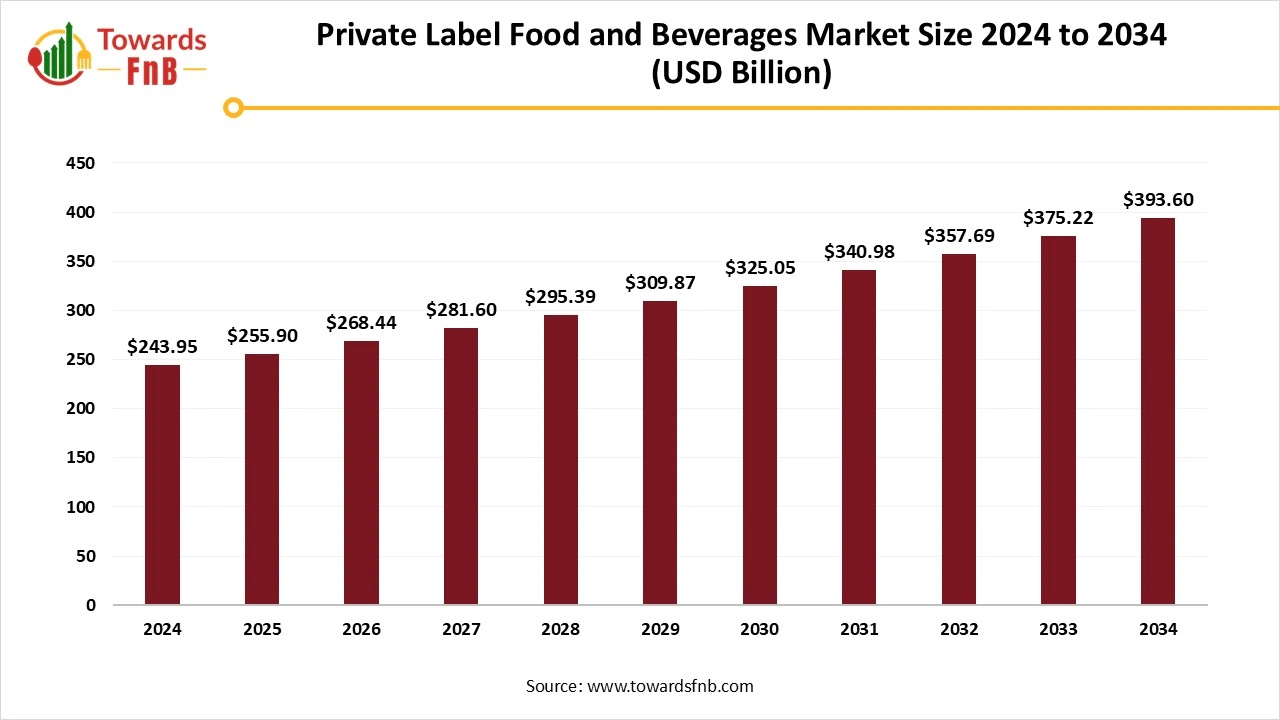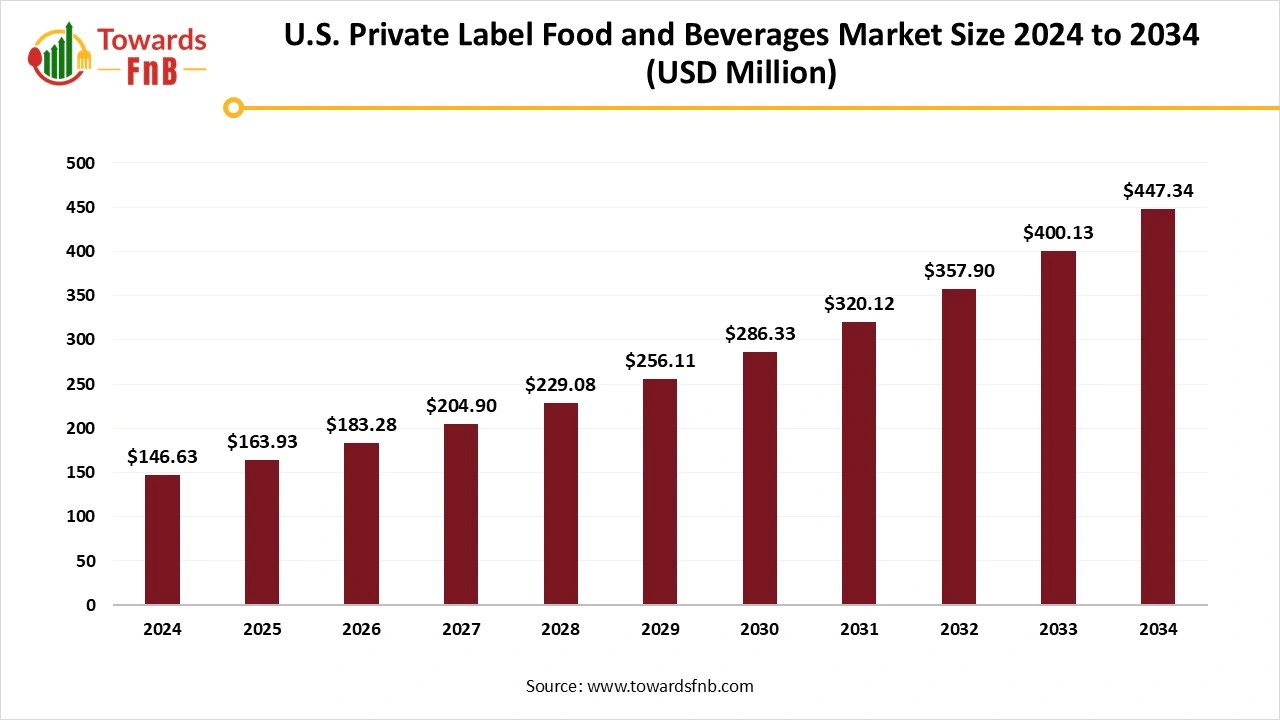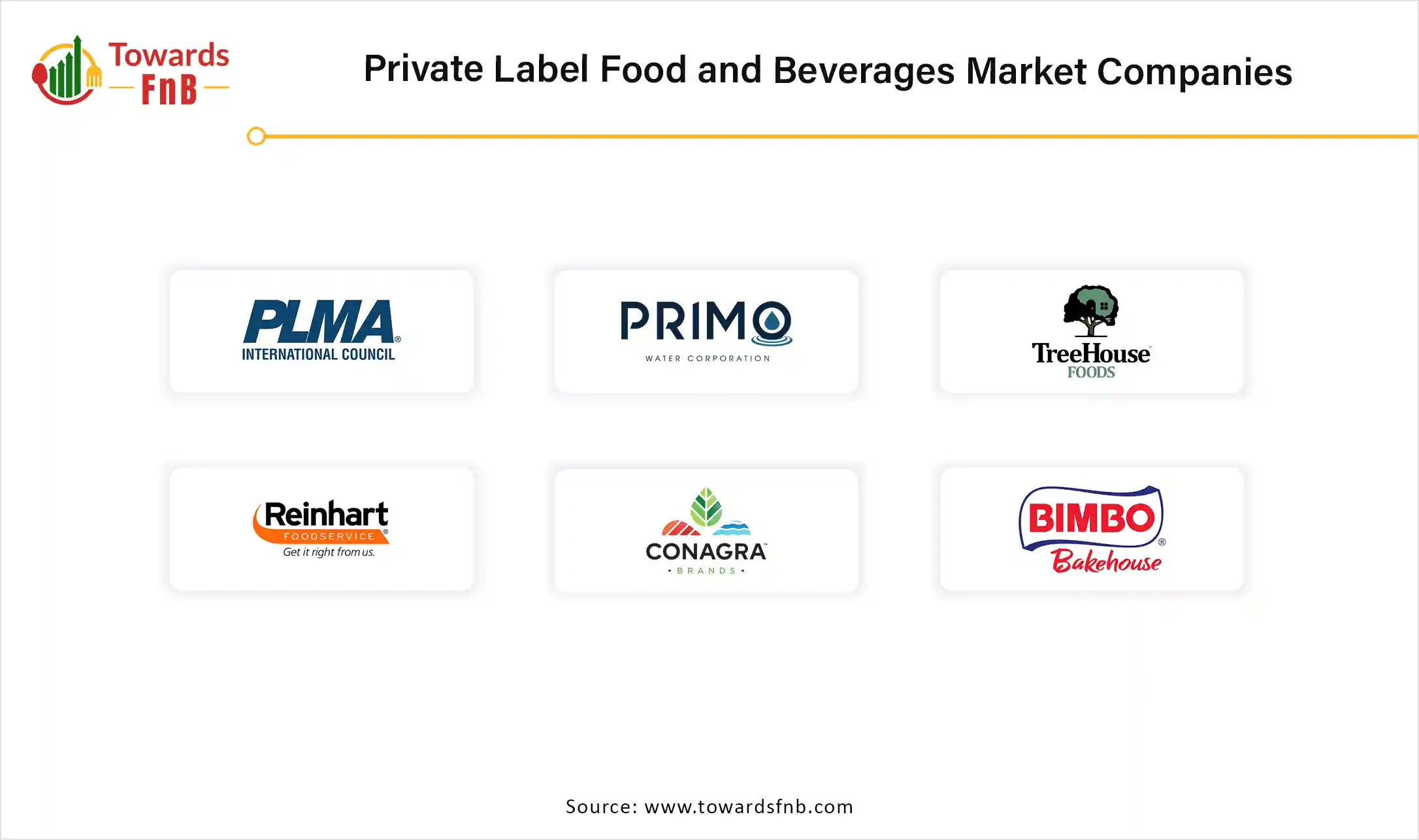November 2025
The global private label food and beverages market size was estimated at USD 243.95 billion in 2024 and is expected to rise from USD 255.90 billion in 2025 to nearly reaching USD 393.60 billion by 2034, growing at a CAGR of 4.9% during the forecast period from 2025 to 2034. The market is significantly expanding due to government initiatives to support private sectors, increasing trend of high-quality, affordable products, along with transformation of private label manufacturers to compete with national level brands.

| Study Coverage | Details |
| Growth Rate from 2025 to 2034 | CAGR of 4.9% |
| Market Size in 2025 | USD 255.90 Billion |
| Market Size in 2026 | USD 268.44 Billion |
| Market Size by 2034 | USD 393.60 Billion |
| Largest Market | Europe |
| Base Year | 2024 |
| Forecast Period | 2025 to 2034 |
| Regions Covered | North America, Europe, Asia-Pacific, Latin America, and Middle East & Africa |
The private label food and beverages Market refers to food and beverage products that are manufactured by third-party manufacturers but sold under a retailer’s brand. These products are also known as store brands, own brands, or house brands. Retailers use private labeling to offer affordable alternatives to branded products while maintaining control over pricing, packaging, and marketing. The market is showcasing a prominent growth rate along with many key trends.
Consumers are majorly opting for healthy food products with premium private food labels to confirm their quality and overall data about their production process and expiry date and how it's beneficial to health or if it's allergen to them or if food and drinks are ethically sourced or not, due to growing environmental awareness. These considerations are considered for various food products like beverages, alcohol, snacks, soup, coffee/tea. Non-veg products, chocolates, bakery products, baby food formulations, and many others. Increasing e-commerce platforms and their influence is another reason why the market is significantly expanding on a global level.
The private label food and beverages market is witnessing a robust growth rate internationally due to its increasing dollar value share, which further affects consumer choices and market expansion, creating lucrative opportunities and various possibilities by which the market may reach its heights. To cater to the consumers' evolving needs, various retailers like dollar stores, department stores, and general merchandise retailers continue to offer such labels to stay competitive in the global market.
Many factors are supporting market growth, such as easy availability, competitive pricing, and the launch of premium and special food and drinks products which cater to these brands to establish them in the global market. Dairy products like yogurt, ice-cream, baby food with milk as a substitute and other products are increasingly adopting private labels due to their perceived quality by consumers.
A notable challenge that the global private-label food and beverages market faces is low penetration of these private labels in developing countries like Switzerland, the UK, Spain and others. In these countries, national brands are highly established and reputed that many people only purchase products of these brands and hesitate to adopt new brands with private labels even though high recognition may hinder the market's growth. Another fact is that consumers are looking not only for branded food and drinks products, but they are seeking cleanable, ethically sourced and health-supportive ingredients in these products due to growing awareness of food and healthcare. Therefore, only good branding practices won't work if ingredients are not transparently displayed, which is creating a barrier to market growth which needs to be taken into account.
U.S. Private Label Food and Beverages Market Size and Growth 2025 to 2034
The U.S. private label food and beverages market was valued at USD 146.63 million in 2024 and is expected to grow from USD 163.93 million in 2025 to roughly USD 447.34 million by 2034, registering a CAGR of 11.8% during 2025 to 2034. Market growth is primarily fueled by rising product innovation and strengthening consumer trust in private label offerings.

This market is experiencing strong growth, driven by increasing innovation in products and rising consumer confidence in private label brands. As retailers continue to enhance quality and expand their offerings, more shoppers are choosing affordable store-brand options over national brands, supporting steady market expansion.
Why does Europe Dominate the Private Label Food and Beverages Market?
Europe dominated the market in 2024. The region is dominated due to various factors, including: many customers are increasingly adopting products that are cost-effective and alternative options for branded food items and drinks as per their choices. Retailers like convenience stores, hypermarkets/supermarkets, local stores, general merchandise stores, department stores and many others are increasingly investing in the promotion of specific products and the development of brands.
To achieve this, private labels play an important role in highlighting brand categories as per their approval and specifications, like non-GMO bakery products, yogurt, ice-cream with their specialty and flavor profiles, dairy products with additives, poultry food products, salads, gravies, fish, general food, savory snacks, various kinds of sauces, soups, processed foods, tea/coffee, water bottles, Sport drinks, juices, carbonated/noncarbonated drinks, confectionery and many more products come under the food and beverage category.
These offerings are accessible with the help of online platforms and offline stores, channels which offer convenience and flexibility in purchasing these products as per consumers' needs. The region is increasingly increasing due to an increasing preference for high-quality food products and a premium private label, which confirms its quality and standards.
Which are the Factors propelling, Asia Pacific Region in the Private Label Food and Beverages Market?
Asia Pacific is expected to grow at the fastest CAGR during the foreseeable period. The region is the fastest growing due to several factors, such as an increasing income rate per capita and a growing middle-class population with notable disposable income, and revolutionary changes in modern retail owing to the urbanization in major cities of countries like China, India, Japan, Korea and others where food and beverage industry is also proliferating on a large scale. Other points are strong retail infrastructure, people’s growing preference for ready-to-eat yet clean-label food and beverages due to a hectic lifestyle and the government’s initiatives to support private sectors to grow in every possible direction, which further impacts the country’s overall economy and growth and appeals to international consumers as well.
Why are Bakeries and Confectionery Growing Significantly in the Private Label Food and Beverages Market?
The bakery and confectionery segment held the largest market share in the private label food and beverages market in 2024. The segment dominates due to growing demand for affordable yet high-quality food and beverages products. Also, private-label brands have gained trust from many consumers as reliable brands for the food and beverage sector.The segment caters to various needs, like sugar-free, gluten-free and lactose-free bakery and confectionery products along with on-the-go products.
The frozen ready-to-eat meal segment is expected to witness the fastest growth rate during the forecasted year. The segment is expanding due to the popularity of frozen food and drinks products as it offers no preparation time, yet high quality food, which is confirmed by premium private labels.
Why are Consumers Opting for Non-Alcoholic Drinks?
The non-alcoholic segment dominated the largest market share in 2024. The segment dominates due to various factors, including changing consumers' preferences, lifestyle changes, increasing awareness about side effects of alcohol, and the presence of various flavored drinks which compete with alcoholic beverages. Consumers are actively looking for healthy fruit juice, beverages, flavored water to stay hydrated and retain energy levels when needed. These products offer natural ingredients and clean label additives to further support market growth.
The functional beverages segment is expected to propel at the fastest growth rate during the foreseeable period 2025-2034. The segment is proliferating due to factors like, increasing shift towards targeted health therapy by incorporating functional beverages as a convenient option for daily use, the rise of veganism along with a proactive approach for preventative healthcare and wellness.
Why are Clean-label Products Gaining Traction?
The clean label segment dominated the largest market share in 2024. The segment dominates the global private-label food and beverages market due to significant changes in the market, such as plant-based transformation in the food and beverage sector and higher transparency about their root source is further fueling the market's growth. Private-label brands are acknowledging this trend and capitalize on it by offering a spectrum of clean label products as per consumers' interests. Clean-label logos and certifications play a key role in gaining a huge consumer base in response to fundamental changes in consumer behavior when it comes to buying food and drinks products.
The vegan/plant-based segment is expected to witness the fastest CAGR during the upcoming period 2025-2034. The segment is witnessing strong growth due to various factors like changing consumer preference and the shift to vegan products as they are ethically sourced and do not involve any harmful activity on animals. Vegan products are easy for the digestion system, which is another factor fueling market growth.
Why has Flexible Packaging Gained Significance in the Private Label Food and Beverages Market?
The flexible packaging segment dominated the largest share of the private label food and beverages market in 2024. The segment dominates due to its versatile offerings like cost-effectiveness, recycling ability, and enhanced product presence. Flexible packaging is gaining traction due to its versatility, like minimizing material usage, cost-effective transportation, and increased shelf life of products, which shows brands' reliability and quality. Demand for on-the-go packaging is a key driver of segments' dominance in the global market.
The tetra pack segment is expected to witness the fastest CAGR during the forecasted period 2025-2034. The segment is significantly growing as tear packaging offers extended shelf life at room temperature and is convenient for traveling purposes, along with sustainable options.
Why are Supermarkets/Hypermarkets Popular in the Private Label Food and Beverages Market?
The supermarkets/hypermarkets segment dominated the global market in 2024. The segment dominates due to their capability to provide a wide range of products with different brands at the same location, and they offer access to private label manufacturers to keep their products in stores. This approach further fuels market growth by responding to the consumer's demand, which is well predictable by supermarket and hypermarket marketers.
The online retail segment is expected to grow at the fastest CAGR during the foreseeable period of 2025-2034. The segment is expanding due to factors like cost-effectiveness, convenience like doorstep delivery of desired products, and an evolving perception of e-commerce platforms which is ideal foundation for expansion of private label food and drink products.
Why does the Household/Retail Segment Expand Significantly?
The household/retail segment holds the largest share of the private label food and beverages market in 2024. The segment dominated due to price sensitivity and a cost-saving approach to high-quality food and drink products. Many times, private label products provide high quality and comparatively low cost, which is a prime requirement of household and retail end users, further strengthening the market's growth. Moreover, to compete with highly established brands, retailers invest hugely in quality ingredients and ethical manufacturing, which are both offered by private label marketers.
The foodservice segment is expected to propel at the fastest growth rate during the foreseeable period. The segment is expanding due to affordable food and beverages options with high quality, which is a specialty of private-label products, along with the expansion of restaurants and various food/drinks outlets across the globe.
How Does Perceived Quality Products Offer Mid-Range Pricing Tier Influences Private Label Food and Beverages Market Growth?
The mid-range segment dominates the private label food and beverages market in 2024. The segment dominates due to the mid-range pricing tier, which provides affordability, along with high-quality food and drink products. Private brands have evolved significantly to compete with the national brands in terms of quality, packaging, and gained consumer reliability along with their cost-effective products. Also, to attract a wide range of consumer bases, many retailers are investing in private-label brands, further fueling the market's growth.
The premium segment is expected to propel at the fastest growth potential during the forecasted year 2025-2034. The segment is prominently growing due to an expanding consumer base who wants to purchase high-quality and premium label products to ensure their reliability while paying more than usual. This trend is majorly noticeable in the younger generation, like Gen Z and millennials, showcasing value-conscious purchasing tendencies.
PLMA
TreeHouse Foods
Lactalis Group

By Product Type
By Drink Product Type Insights
By Formulation / Health Claims
By Packaging Type
By Sales Channel
By End Consumer / Application
By Pricing Tier
By Region
November 2025
November 2025
November 2025
November 2025